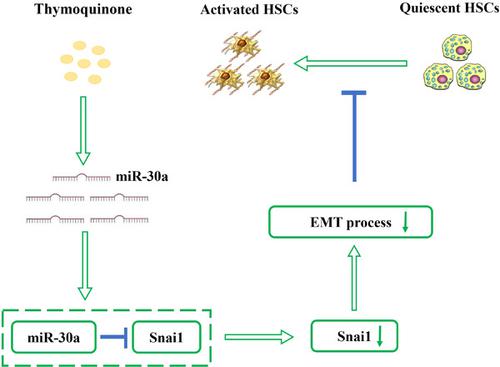当前位置:
X-MOL 学术
›
J. Cell. Physiol.
›
论文详情
Our official English website, www.x-mol.net, welcomes your
feedback! (Note: you will need to create a separate account there.)
Thymoquinone alleviates liver fibrosis via miR‐30a‐mediated epithelial‐mesenchymal transition
Journal of Cellular Physiology ( IF 4.5 ) Pub Date : 2020-10-08 , DOI: 10.1002/jcp.30097 Wujun Geng 1 , Chunxue Li 2 , Yating Zhan 2 , Rongrong Zhang 2 , Jianjian Zheng 2
Journal of Cellular Physiology ( IF 4.5 ) Pub Date : 2020-10-08 , DOI: 10.1002/jcp.30097 Wujun Geng 1 , Chunxue Li 2 , Yating Zhan 2 , Rongrong Zhang 2 , Jianjian Zheng 2
Affiliation

|
Thymoquinone (TQ), the main active constituent of Nigella sativa seeds, has been shown to play a role in antioxidation, anti‐inflammation, and antitumor. Recent studies have demonstrated that TQ contributes to the suppression of liver fibrosis. Abnormal activated epithelial‐mesenchymal transition (EMT) promotes the activation of hepatic stellate cells (HSCs). However, whether the antifibrotic effects of TQ occur through inhibiting EMT is largely unknown. In this study, it was found that TQ ameliorated liver fibrosis and collagen accumulation in carbon tetrachloride (CCl4) mice. In vitro, TQ inhibited HSC activation including reduced proliferation, α‐smooth muscle actin, and collagen. In addition, TQ markedly suppressed the EMT process, with enhanced E‐cadherin and reduced desmin. Notably, snail family transcriptional repressor 1 (Snai1), the EMT master transcription factor, was obviously inhibited by TQ in vivo and in vitro. Further studies demonstrated that Snai1 was a target of microRNA‐30a (miR‐30a), which was upregulated by TQ. Interestingly, the effects of TQ on HSC activation and EMT were almost inhibited by miR‐30a inhibitor. Collectively, we demonstrate that TQ inhibits HSC activation, at least in part, via regulation of miR‐30a and Snai1. TQ upregulates miR‐30a expression, resulting in a reduced Snai1 level as well as EMT process inactivation, which contributes to the inhibition of HSC activation. TQ may be a potential therapeutic agent for liver fibrosis.
中文翻译:

百里醌通过 miR-30a 介导的上皮间质转化减轻肝纤维化
百里醌(TQ)是黑种草种子的主要活性成分,已被证明具有抗氧化、抗炎和抗肿瘤作用。最近的研究表明,TQ 有助于抑制肝纤维化。异常激活的上皮间质转化(EMT)促进肝星状细胞(HSC)的激活。然而,TQ 的抗纤维化作用是否通过抑制 EMT 发挥作用尚不清楚。在这项研究中,发现 TQ 可改善四氯化碳 (CCl 4 ) 小鼠的肝纤维化和胶原蛋白积累。在体外,TQ 抑制 HSC 活化,包括减少增殖、α-平滑肌肌动蛋白和胶原蛋白。此外,TQ 显着抑制 EMT 过程,增强 E-钙粘蛋白并减少结蛋白。值得注意的是,EMT主转录因子蜗牛家族转录阻遏蛋白1(Snai1)在体内和体外均被TQ明显抑制。进一步的研究表明,Snai1 是 microRNA-30a (miR-30a) 的靶标,TQ 上调该靶标。有趣的是,TQ 对 HSC 激活和 EMT 的影响几乎被 miR-30a 抑制剂抑制。总的来说,我们证明 TQ 至少部分通过调节 miR-30a 和 Snai1 抑制 HSC 激活。 TQ 上调 miR-30a 表达,导致 Snai1 水平降低以及 EMT 过程失活,从而有助于抑制 HSC 活化。 TQ可能是肝纤维化的潜在治疗剂。
更新日期:2020-10-08
中文翻译:

百里醌通过 miR-30a 介导的上皮间质转化减轻肝纤维化
百里醌(TQ)是黑种草种子的主要活性成分,已被证明具有抗氧化、抗炎和抗肿瘤作用。最近的研究表明,TQ 有助于抑制肝纤维化。异常激活的上皮间质转化(EMT)促进肝星状细胞(HSC)的激活。然而,TQ 的抗纤维化作用是否通过抑制 EMT 发挥作用尚不清楚。在这项研究中,发现 TQ 可改善四氯化碳 (CCl 4 ) 小鼠的肝纤维化和胶原蛋白积累。在体外,TQ 抑制 HSC 活化,包括减少增殖、α-平滑肌肌动蛋白和胶原蛋白。此外,TQ 显着抑制 EMT 过程,增强 E-钙粘蛋白并减少结蛋白。值得注意的是,EMT主转录因子蜗牛家族转录阻遏蛋白1(Snai1)在体内和体外均被TQ明显抑制。进一步的研究表明,Snai1 是 microRNA-30a (miR-30a) 的靶标,TQ 上调该靶标。有趣的是,TQ 对 HSC 激活和 EMT 的影响几乎被 miR-30a 抑制剂抑制。总的来说,我们证明 TQ 至少部分通过调节 miR-30a 和 Snai1 抑制 HSC 激活。 TQ 上调 miR-30a 表达,导致 Snai1 水平降低以及 EMT 过程失活,从而有助于抑制 HSC 活化。 TQ可能是肝纤维化的潜在治疗剂。











































 京公网安备 11010802027423号
京公网安备 11010802027423号